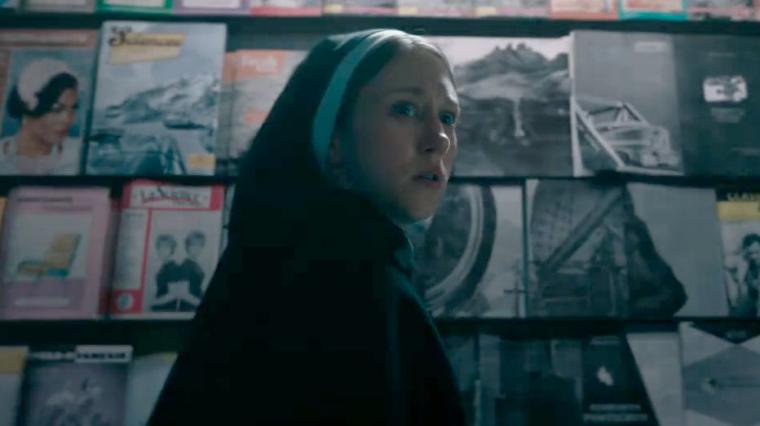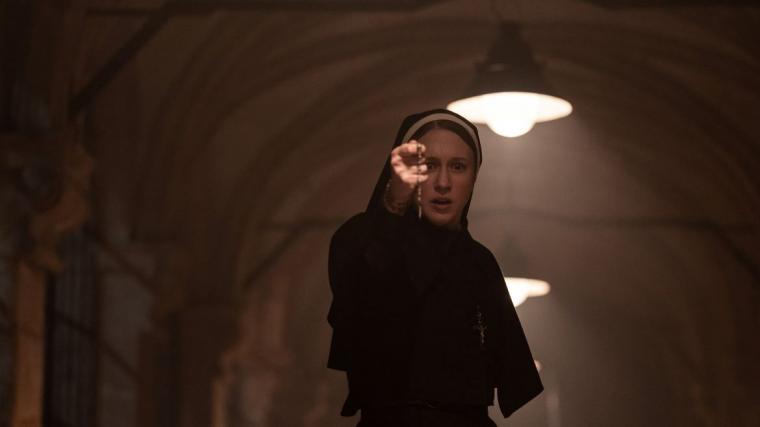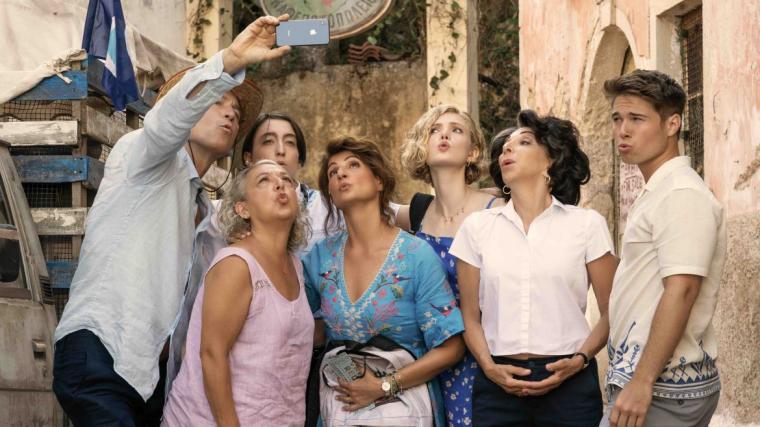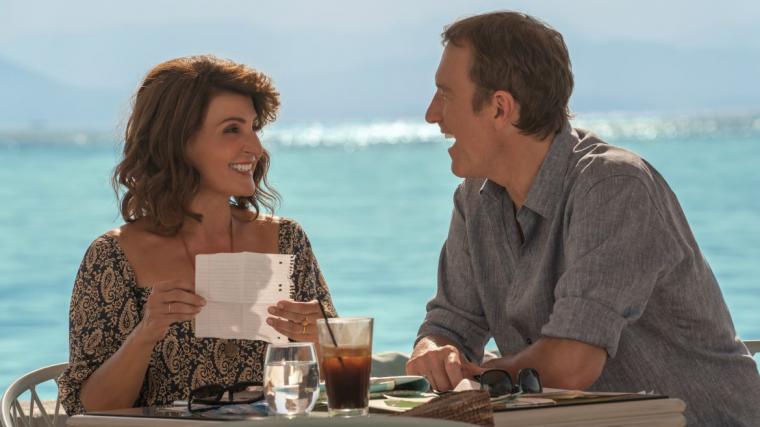
Tassia Farmiga in The Nun II
THE NUN II
Honestly, it sometimes feels like the only thing getting me though the extended Conjuring Universe, which is now nine films old and counting, is Wikipedia.
I know that I saw 2018's The Nun, partly because I remember the image of pop-eyed Taissa Farmiga in a habit, and mostly because, back in the day, I apparently had enough opinions to compose more than 600 words on the experience. (My past reviews, I should add, are also tremendously beneficial in recalling this franchise's particulars.) Yet beyond recalling Farmiga's presence and remembering that the movie's supernaturally hideous title character was played by the same woman (Bonnie Aarons) who portrayed David Lynch's unforgettably scary dumpster bum in Mulholland Dr., every other salient detail from director Corin Hardy's Nun II predecessor had vanished from memory. I'd even completely forgotten about the friendly jack-of-all-trades Frenchman, a dude unimaginatively nicknamed “Frenchie,” who wound up saving Farmiga's protagonist Sister Irene in the original and was subsequently possessed by Aarons' demon Valak. Five years ago, I wrote that Frenchie portrayer Jonas Bioquet was reminiscent of Jason Segel. Now he seems more like a blend of Paul Mescal and Theo James with a dash of mid-'00s Josh Lucas. What this appealing Belgian isn't yet is a screen performer with a look and presence to call his own.
Regardless, Bioquet is now back, and Farmiga is back, and this Gothic-horror outing takes place four years after the events of its 1952-set predecessor, with Valak – now (mostly) using Frenchie as her human host – blazing a trail from Hungary to France in search of a religious tchotchke and leaving loads of nonsecular corpses in her/his/its wake. I use a parenthetical on that “mostly” because the logic behind Valak's appearances is left maddeningly vague. Yes, the Satanic entity frequently enters Frenchie's body and forces him to commit heinous atrocities, duties that Bioquet enacts with the proper fright-flick enthusiasm. But Valak also appears as glowing-eyed visages of herself, and as a weakly rendered dog-like creature, and apparently has the ability to be in multiple locations at once – in the movie's final half hour, which is easily The Nun II's nadir, she seems to make at least a half-dozen physical appearances in alternating spots within the same scene. So why, exactly, is she possessing the body of the handsome lad with the bedroom eyes and chin stubble and slo-o-o-owly making her way across Europe to locate said religious artifact? Couldn't she save some time and just make countless versions of herself to find the thing?

It's of course ridiculous to ask for narrative coherence and, you know, basic common sense in movies of this type. But just because a demonic apparition can do anything doesn't mean that it should be able to do everything, and if you give director Michael Chaves' The Nun II even a millisecond of thought, the entire structure comes crumbling down. Let's scoot toward the end and posit that literally nothing that happens here can be considered a spoiler, considering that almost nothing in the film makes the slightest bit of sense. When Fargiga's spunky young nun, who's also a preternaturally gifted exorcist, brandishes the fabled relic of St. Lucy and points it at Valak's face, the demon howls in agony. Yet the demon also desperately wants the relic, and when she finally nabs it, it seems to augment her already considerable power. (In Chaves' most unintentionally hilarious scene, Valak, in Frenchie's body, holds it above her head while Sister Irene and her sidekick Sister Debra – a badly miscast Storm Reid – try to reclaim it, suggesting a Catholic-horror version of Keep Away.) And while our heroines are engaged in that silly business, a group of students at the French girls' school are running and shrieking – God, so much shrieking – from nightmarish offshoots of Valak empowered to deliver jump scares in rooms not remotely connected to one another. Precisely what is happening here? If Valak can be, to borrow the term, everything everywhere all at once, where's the shock in her arrivals?
As Chaves' film ambles on at 110 minutes, it becomes pathetically easy to figure out where the jump-scares are going to come from: Just look toward the portions of the frame where you least expect them. That said, the director delivers a few creepy tingles with true elan. Though over-exposed in the trailers, that bit with the newsstand magazines frantically, unnaturally flipping to finally land on a makeshift image of Aarons' nun is fiendishly well-executed (and, happily, lasts a lot longer than the previews indicated). There's a giddily unsettling moment in which a door opens to reveal the titular figure in what looks like Kubrick's Shining hallway where the deceased twin girls were butchered – a standalone freak-out quickly matched by Valak meeting the impressive Katelyn Rose Downey's pre-teen Sophie in a significantly darker hallway and just standing there, grinning. (A return to my 2018 review of The Nun reminded me that the demon spoke, and even made wisecracks, in the original – here, she's taken a blessed vow of silence.)
And beyond the enticing prelude and admirable shots of Aarons, courtesy of Chaves and cinematographer Tristan Nyby, almost allowing you to view its titular creature amidst the shadows, The Nun II is almost worthwhile for the end-credits scene that brings Conjuring stars Patrick Wilson and Taissa's big sister Vera Farmiga back into the labyrinthine Universe mix. This is in no way a spoiler; the actors' appearances don't in any way affect this part of the story. But seeing Vera in the same movie as her real-life younger sister Taissa – a woman who, though 21 years younger than Vera, is a spitting image – is still a bit of a jolt, and provides enough mystery about the possible connection between Vera's Lorraine Warren and Taissa's Sister Irene to wonder if there are further Conjuring Universe mysteries left to unpack. Against all expectation, to say nothing of care for my franchise-averse well-being, I'm kind of hoping there are.

MY BIG FAT GREEK WEDDING 3
Unlike the original that debuted way back in 2002, writer/director/star Nia Vardalos' My Big Fat Greek Wedding 3 isn't a comedy for viewers who want just the mildest of conflict in their movies. It's for people who want zero conflict in their movies. Zilch. Nada. I've never seen anything quite like it – or maybe I have, considering that my memories of 2016's My Big Fat Greek Wedding 2 are even less assured than my shaky memories of the first Nun. (During a recent radio segment, I told the show's hosts that the wedding in MBFGW2 involved Vardalos' on-screen niece, which couldn't have been further from the truth – a subsequent Wikipedia search showed that the plotting actually led to a pair of wedding renewals, and so far as I can tell, Vardalos' heroine Toula doesn't have a niece. Whoops! Or as they apparently say in Greece: “Whoops-a!”)
Relentless sunniness has its place, as it certainly does in the Greek locales where MBFGW3 was shot; the typically over-bright sitcom lighting is hardly a distraction considering how much it adds to our enjoyment of the mouth-watering food-porn. But if the recent Book Club: The Next Chapter, which sent its leads to Italy, was astounding for the way it turned every potential calamity into a mere laugh-it-off incident, Vardolos' second sequel is legitimately stupefying in its habit of setting up possible narrative crises only to resolve them in their subsequent scenes, or ignore their implications altogether. Time and again, Toula and her extended clan – making a promised pilgrimage to Greece after the death of patriarch Kostas Portokalos, whose portrayer Michael Constantine died in 2021 – are faced with problems. There are no vacancies at any hotels. (Seven Americans travel abroad and don't book rooms in advance?!) No one appears to be coming to the planned village-wide reunion. Paris (Elena Kampouris), the collegiate daughter of Toula and her non-Greek husband Ian (John Corbett), is secretly on academic probation. There are even theoretical tribulations for characters we're meeting for the first time, chiefly the cute-as-buttons couple Peter and Qamar (Alexis Georgoulis and Stephanie Nur), who fear the familial ramifications of his being Greek and her not … just like what happened for Toula and Ian in 2002!
To say these issues are swiftly handled would be gross understatement. They, and others like them, are magically swiftly handled. Toula spends half the movie whining that she can't find her late father's three childhood best friends in order to invite them to the reunion, even though all we see of her efforts is her asking a single cashier for their whereabouts. Ian finds these guys in one random encounter with a monk. Toula consequently doesn't know how they're going to gather the men from three separate islands in time for the celebration. Her cousins (Gia Carides and Joey Falcone) immediately fly from New York to Greece and amass them in less than a day. Toula's brother Nick (Louis Mandylor) smuggles their dad's ashes overseas – just like Diane Keaton did in the Book Club sequel! – and faces Toula's wrath. Well, near-wrath; she's fine with it the next time they meet. With aching predictability and not a scintilla of wit, one B-plot after another is taken care of though the simplest, most unfunny methods possible, and by the end of the film, I was hoping there was always an on-set nurse with ointment at the ready, given that the actors' torsos must have been severely chafed by the incessant on-screen hugs.

I hasten to add that, at the crowded matinée screening I attended, none of this seemed to brother my fellow patrons, who dutifully cackled at Mandylor shaving his ears and nostrils at the breakfast table, and the errant goat that wandered into the clan's sole bedroom, and the sight of Vardalos comically unable to straddle a horse. I spent most of the movie's 91 minutes wishing I were anywhere else, mostly busying myself with figuring out which performer was giving the most embarrassing performance. (Melina Kotselou gave him a run for the money with her self-appointed mayor's catchphrase “Number one – the best!” uttered as many times as Fonzie's “A-a-a-a-a-ayyy!” during Happy Days' entire run, but Corbett still takes the cake. The meaningless goofy faces he consistently makes made me think that Corbett was reasonably sure no one would ever see this movie and tease him for it later.)
Yet with literally five minutes to go before the end credits, dammit if the movie doesn't pull off a real beauty of a sibling-bonding scquence, with Toula and Nick forced to admit that, with their dad gone and their mom (Lainie Kazan in a rather heartbreaking pair of minor scenes) in the early stages of Alzheimer's, the unofficial role of “head of the family” has to fall to one or both of them. Even if I never once laughed at this three-quel and active grimacing became my default mode, I did find moments of modest enjoyment: in the geographic and food photography; in the winning presence of Kampouris; in the effortless camaraderie between the aunts played by Maria Vacratsis and the invaluable Andrea Martin. Yet for a few precious minutes toward the climax, the generally over-enthusiastic Vardalos and Mandylor finally create a relaxed and deeply welcome performance rhythm, and remind you what first drew us to the Portokalos clan 20-plus years ago. It's nowhere near enough to make up for the rest of My Big Fat Greek Wedding 3, but if a part four is (hopefully not) on the horizon, at least it's a start.








